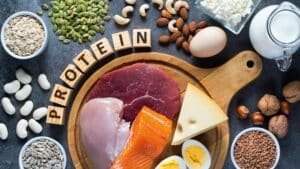
We all know how confusing food advice can be. Eat this. Don’t eat that! And a quick search on Amazon will come up with tens of thousands books on diets. We’re overwhelmed by conflicting advice.
Personally, I like to go back to science and think about what food is. From a chemical point of view, it’s just different combinations of atoms – such as carbon, oxygen and nitrogen – that nourish us.
When it comes down to basics: we can be over-nourished (too many calories) or undernourished (too few calories). We can be building muscle or losing it. Each of us is different in how our bodies use food, but the good news is that we can measure objectively how we’re doing.
How Do I Know How My Body Is Doing?
One basic way is to measure our body mass index (BMI), which measures body fat based on height and weight. That’s a good start.
We can also check our bone density through a DEXA scan.
Another measurement we can do at home is to measure how much muscle mass we have. There are a bunch of smart scales that will measure more than weight. A Google search for best smart scales will quickly find them. Look for one that measures muscle mass; sometimes measured as skeletal muscle.
What Is Muscle Mass?
Muscle mass is calculated by subtracting our fat from our overall weight. So muscle mass includes our bones and fluids.
Unfortunately, as we age, we lose muscle through what doctors call sarcopenia, a natural part of aging. Research shows that we typically lose between 5 to 13% of our muscles by our sixth and seventh decades.
Can I Reverse Muscle Loss?
We can build muscle mass through diet and exercise. The building blocks of muscle are proteins so it’s critical that we’re eating enough protein.
How much protein we need depends on how active we are. The US Dietary Guidelines for Americans recommend 0.8g of protein per kilo of weight for an average adult, who doesn’t exercise that much.
More protein is better, particularly if you’re active and exercising. The Mayo Clinic recommends 1.1 to 1.5 grams of protein per kg of weight for people who exercise regularly, so about 113 grams of protein a day for a woman, who weighs an average 75.5 kilos.
The good news is that if we eat too much protein, we’ll just excrete it in urine. So this is a case of more is better than less.
What Does 113 Grams of Protein Look Like?
It might feel a bit weird to start weighing food, but I’ve found it helps to get a feel for what an ideal protein day looks like. Reading labels on food also helps. I also use Google to answer basic questions like: how much protein is in a cup of peas?
Look for sources online like the USDA (US Department of Agriculture), which has done the hard work in analyzing what’s in what we eat.
As an example: I weigh 70 kgs and I exercise regularly, so I need 70 x 1.1 grams of protein a day minimum. That’s 77 grams of protein. Once I start adding it up, I really have to work at getting enough protein into my diet.
Here’s an example of what a minimum 77-gram protein day looks like for me:
Breakfast:
¾ cup of yogurt = 7g
2 tablespoons of flax = 3g
1 egg = 6g
Snack
¼ cup of walnuts = 5g
Lunch
Piece of salmon (150g) = 30g
1 cup of spinach = 1g
1 slice of bread = 2g
1 avocado = 3g
1 cup of green peas = 8g
Snack (ideally after exercise)
Protein shake = 15g
100g of almonds = 21g
Total protein: 80g
This is just one example of a protein day. There are many great combinations of food that will fuel your body. The key to success is in finding one that works for you.
Let’s Have a Conversation:
How much protein a day should you be eating, based on your weight and activity? How much protein are you eating now? What foods are high in protein that you could incorporate into your diet?





